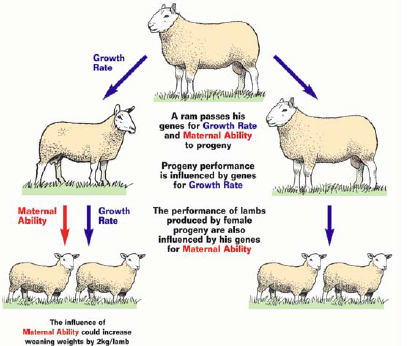Maternal Ability EBV in Sheep
Changes to the calculation of the Maternal Ability EBV in Sheep
The Maternal Ability EBV is designed to identify breeding lines where ewes express superior maternal performance as mothers. In this context “maternal performance” is being assessed in terms of lamb growth rate, highlighting that element of 8 week weight that is due to the maternal care and milk provided to the lamb by its mother.
The Maternal Ability EBV is expressed independently of prolificacy, although it does take into account the number of lambs that a ewe is rearing so that the Maternal Ability EBV of a ewe producing singles/multiples is not biased in any way.
The raw data measurement used to assess a ewe’s maternal ability is the 8 week weight of her lamb or lambs.
Recent changes to the Maternal Ability EBV
Work within the Lleyn and Dorset breeds has identified the need for a better way to assess maternal ability and the approach used in these breeds has now been rolled out to other breeds.
 How has the calculation of the Maternal Ability EBV changed?
How has the calculation of the Maternal Ability EBV changed?
Historically it has been difficult to model the direct and maternal genetic influences on animal performance simultaneously due to the computational power required and software limitations within some of the statistical packages used.
The old approach that was used to calculate the Maternal Ability EBV didn’t tease out the maternal influence of a ewe’s genetics on lamb performance. Instead, it was analysed as a separate weight trait attributed to the ewe for which there would be multiple records based on the number of lambs the ewe had produced.
The new approach takes direct and maternal genetic influences on lamb 8 week weight into account simultaneously.
Eight week weights are analysed to take into account
- The contemporary group in which lambs are reared – taking into account flock/season/sex
- Litter size reared
- Dam age
- Direct genetic influence on lamb growth rate from sire and dam – this becomes the Eight Week Weight EBV
- Maternal genetic influence on lamb growth rate from dam – this becomes the Maternal Ability EBV
- Temporary environmental influences on the lamb
- Permanent environmental influences on the dam
How does the analysis decide to attribute weight gain to either the lambs own genes for growth or its mother’s milking ability?
Imagine a ram being used within a flock over a period of time. In the first generation his progeny – male and female will be directly influenced by his genes for growth rate. In the next generation his daughters will produce lambs whose performance is influenced by the sire’s genes for growth and also his genes for milk production now being expressed by his daughters.
If the analysis determines that his daughters are constantly producing much heavier lambs than those produced by his sons – having taken environmental and genetic differences into account – then this difference is attributed to the maternal ability (milk and maternal care) of his daughters
How are embryo recipient ewes and foster ewes handled within the BLUP analysis?
Providing that embryo transfer and foster details are recorded correctly, the analysis recognises that the ewe rearing the lamb is not its natural mother and hence its genetic dam is credited with having provided genes that may have influenced the lambs growth rate, but is not given any credit for having reared the lamb – this credit is attributed to the recipient/foster ewe.
What happens when a ewe gets mastitis?
In an ideal world a record would be held indicating if the ewe had mastitis and this environmental influence could be fitted within the BLUP model. In practice this data is not available and breeders are left with the options of omitting weight data for these lambs or putting them in a separate management group.
If records are submitted for lambs produced by ewes suffering from mastitis the analysis will still try to handle the data correctly to avoid introducing sudden bias into the breeding value calculations.
Records are not analysed in isolation and the algorithms used will pick up and try and take into account unusual lamb weight profiles, for example, a ewe that has produced heavy lambs for three seasons and then lighter lambs for the next two, or a ewe where one lamb is markedly lighter than the other. Even a young ewe succumbing to mastitis will not see her EBVs automatically downgraded if a large number of her full and half-sisters are performing well; again the analysis still has confidence that the genetics within this breeding line are performing well.

